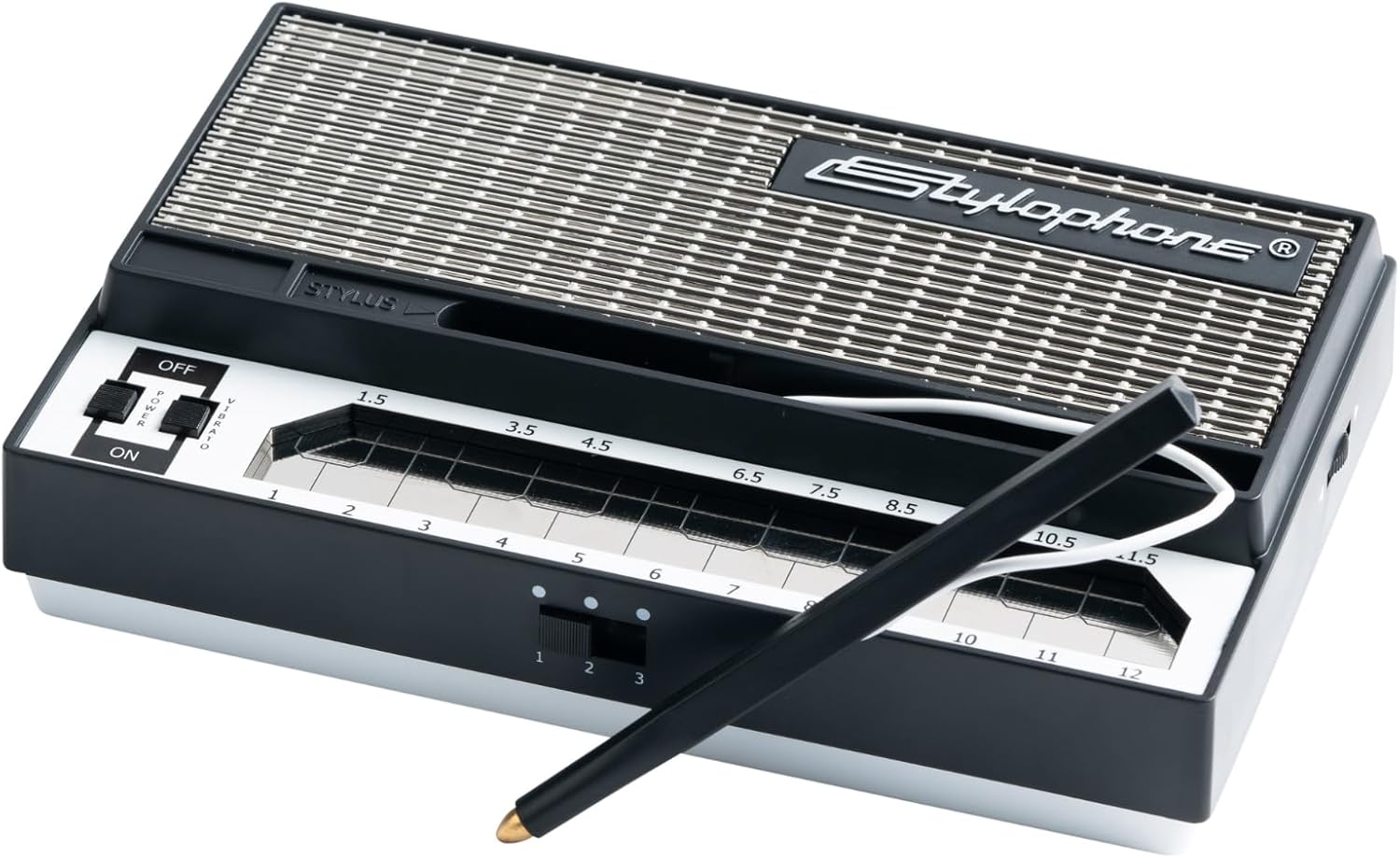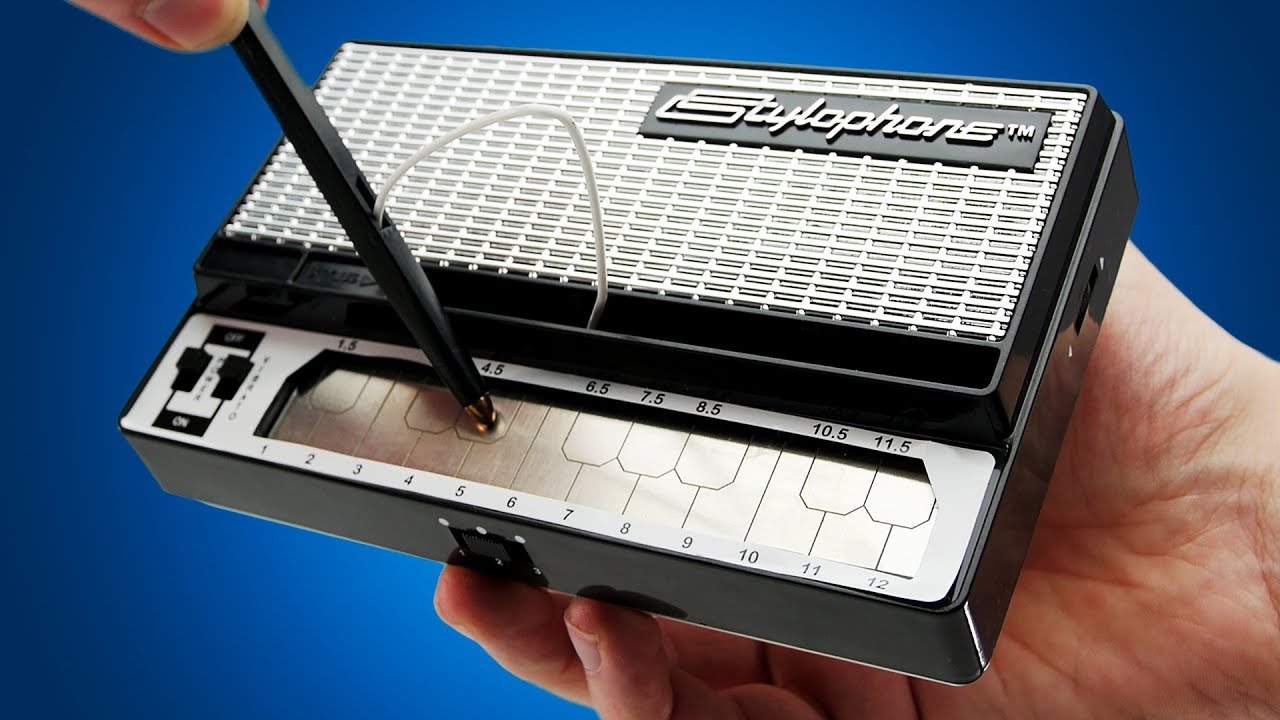Stylophone
Electronic Instruments
Europe
Between 1901 and present
Video
The Stylophone is a compact, battery-operated electronic musical instrument known for its distinctive sound and unique playing mechanism. Developed in the late 1960s, it belongs to the category of monophonic analog synthesizers and is played using a stylus, which is used to touch a metal keyboard. The instrument produces sound by closing a circuit when the stylus makes contact with the keys, generating a buzzing, electronic tone that has become synonymous with retro-futuristic music.
The Stylophone is often classified as a portable synthesizer due to its electronic sound production and modulation capabilities. Unlike traditional keyboards, which rely on hammers, strings, or mechanical actions, the Stylophone operates purely through electronic means, making it one of the simplest yet innovative musical instruments of its time. It is monophonic, meaning it can only produce one note at a time, limiting its capability for chord playing but making it ideal for melody lines and lead parts. This instrument is especially notable for its small size and ease of use, which has made it popular among both professional musicians and hobbyists. Despite its simplicity, the Stylophone has played a crucial role in various music genres, particularly in experimental, electronic, and pop music.
History and Origin
Continent and Invention Period
The Stylophone originated in Europe, specifically in the United Kingdom, during the late 20th century. It was invented in 1967 by British inventor Brian Jarvis, who designed it as an easy-to-play instrument that could be used by musicians and non-musicians alike. Jarvis, along with his company Dubreq, developed the Stylophone as a low-cost, accessible musical instrument with a futuristic appeal. The late 1960s was a period of significant innovation in electronic music, with synthesizers and electronic instruments beginning to gain mainstream recognition. The Stylophone capitalized on this trend by offering an affordable and portable alternative to larger synthesizers, which were expensive and complex at the time.
The instrument was officially launched in 1968 and quickly gained popularity, thanks in part to celebrity endorsements, most notably from David Bowie, who famously used it in his song “Space Oddity.” This association helped cement the Stylophone’s place in popular music history, making it an iconic instrument of the electronic music revolution.
Evolution Over the Decades
Following its initial success, the Stylophone went through several iterations, with improvements in sound quality and features. The original 1968 model was followed by an upgraded version with additional tone control options. However, by the late 1970s, interest in the Stylophone waned as more advanced synthesizers became available.
Dubreq ceased production in the early 1980s, but the instrument remained a cult favorite among musicians and collectors. In the early 2000s, due to renewed interest in retro electronic music, Dubreq reintroduced the Stylophone with updated features while retaining its classic design and sound. Today, modern versions of the Stylophone include features such as built-in speakers, headphone jacks, and even MIDI compatibility, ensuring its continued relevance in contemporary music production.
Types and Features
The Stylophone has evolved into several different models over the years, each with its own distinct features and capabilities. The core design remains the same, but enhancements in sound generation and modulation have allowed the instrument to expand its versatility.
Types of Stylophones
Original Stylophone (1968) – The first model, featuring a simple metal keyboard and a built-in speaker. It had a single tone and was widely used for simple melodies. Stylophone 350S – A more advanced version introduced in the 1970s, featuring additional tone variations and vibrato effects. This model was larger and offered a wider range of sounds. Stylophone S1 (Reissue) – A modern version released in the 2000s, maintaining the classic design while adding new features such as volume control, headphone output, and improved circuitry. Stylophone Gen X-1 – An advanced version introduced in 2017, featuring a variety of effects, including delay, filter modulation, and sub-octave generation, making it more suitable for experimental music.
Key Features
Stylus-Based Playing – The unique method of playing using a stylus provides a distinctive feel, unlike traditional keyboard instruments.
Battery Operated – Most Stylophones run on batteries, making them highly portable.
Monophonic Sound – The instrument produces one note at a time, making it ideal for lead melodies.
Vibrato Effect – Many models include a built-in vibrato switch to add expression to the sound.
Tuning Control – Some models allow for pitch adjustment, providing additional flexibility for performance and recording.
Work Mechanics
The mechanics of the Stylophone are relatively simple yet effective. The instrument consists of a small metallic keyboard and a circuit board that generates an electronic signal when the stylus makes contact with a key. This signal is then amplified and played through a built-in speaker or an external output.
Sound Generation – The Stylophone works by completing an electrical circuit when the stylus touches a key. Each key corresponds to a different resistance value, determining the pitch of the note produced. Amplification – The sound is amplified either through the built-in speaker or via an external output to a larger sound system. Vibrato and Effects – Some models include a vibrato effect that modulates the frequency of the sound, creating a wavy, tremolo-like effect. The more advanced Gen X-1 model features additional effects, such as delay and filtering, which allow for greater sound manipulation. Pitch Control – Some versions of the Stylophone include a tuning knob, allowing users to fine-tune the instrument or create pitch bends for added musical expression.
Role in Music
The Stylophone has been used in various musical contexts, ranging from experimental compositions to mainstream pop music. Its distinctive buzzing tone and ease of use make it a unique addition to many musical arrangements.
Experimental and Electronic Music – Due to its raw, electronic sound, the Stylophone has found a place in experimental music. Artists exploring unconventional soundscapes often incorporate it into their compositions for its distinctive tone.
Pop and Rock Music – The instrument gained widespread recognition in the late 1960s and 1970s, appearing in popular music tracks such as David Bowie’s Space Oddity. Several other artists, including Kraftwerk and Pulp, have also used the Stylophone in their recordings.
Film and Television Scores – The instrument’s futuristic and quirky sound has made it a favorite for film and TV soundtracks, particularly in sci-fi and retro-themed productions.
Education and Learning – Due to its simplicity, the Stylophone is often used in educational settings to introduce students to electronic music concepts.
Playing Methods and Roles in Music
The Stylophone is played by tapping or sliding the stylus along the metal keyboard. Its simplicity makes it accessible to beginners, while its unique sound has inspired creative uses by professional musicians. The Stylophone has been used in various genres, from pop and rock to electronic music. Artists such as Kraftwerk, Pulp, and Belle and Sebastian have incorporated the Stylophone into their music, showcasing its versatility.
Significance of the Stylophone
The Stylophone holds a unique place in musical history, both as an innovative electronic instrument and as a symbol of accessibility in music-making.
The Stylophone is considered an iconic instrument of the late 20th century, representing the fusion of music and technology. Its popularity in the 1960s and 1970s helped introduce electronic music to a wider audience. One of the most significant aspects of the Stylophone is its affordability and ease of use. Unlike traditional synthesizers, which require extensive knowledge and expensive equipment, the Stylophone offers a simple way for anyone to experiment with electronic sounds. While not as complex as modern synthesizers, the Stylophone has influenced the development of electronic music by demonstrating that electronic sound production can be compact and user-friendly. The instrument has experienced a revival in recent years, with new models incorporating modern features while retaining the classic appeal. Musicians and producers continue to experiment with its unique sound in contemporary music.
The Stylophone is a fascinating musical instrument with a rich history and an enduring legacy. Its simple yet effective design, unique sound, and accessibility have made it a beloved tool for musicians across generations. From its invention in the 1960s to its continued use in modern music, the Stylophone remains an iconic example of how innovation in musical instruments can shape the evolution of sound and creativity.
FAQ
What is the origin of the Stylophone?
The Stylophone was invented in 1967 by Brian Jarvis of Dubreq Studios in the UK. It was designed as a simple electronic instrument played with a stylus on a metal keyboard.
How did the Stylophone become popular in music history?
The Stylophone gained popularity due to its unique sound and portability. It was famously used by David Bowie in "Space Oddity" and has been featured in various music genres since then.
What role does the Stylophone play in modern music?
The Stylophone continues to inspire musicians with its distinctive sound. It is used in electronic and indie music, often for its retro aesthetic and creative sound possibilities.
 Links
Links
References
 Similar
Similar
Instruments
Other Instrument
Categories



















